Standing next to Shana Nys Dambrot comes with perks. The best arrived a few months ago when we were both invited to the house of artist Huguette Caland. Dambrot, a long-time friend of the artist, has incredible admiration for her works, so I sensed I was in for an enjoyable experience. When we arrived at her Los Angeles house, not far from the Santa Monica Airport, I gazed at Caland’s large, two-story, unadorned structure, which had only one or two narrow windows. It had the look of an adobe compound.
The entrance was through a narrow path on one side of the house that gave way to a brightly colored textured wooden door which my brain translated as, “Bet you didn’t expect this door did you?” The sheer contrast of a variegated, artistic-looking door next to an otherwise bare wall was startling and filled one with immense curiosity as to what might lie behind such a door.
Before I describe the inside of the house, a short word about the famous Lebanese artist Huguette El Khjoury Caland, who has made her house a refuge, or better still, a monastery for the creation of art. A resident of Los Angeles since 1988, she is one of Lebanon’s most accomplished women artists. Like Helen el Khal, another well-known Lebanese artist, she took advantage of the new freedom accorded women in some of the Middle East cosmopolitan centers such as Beirut. Caland was born in that city in 1931 at a time when modern art and, even more significantly, art by female artists were first being exhibited in Lebanon. As the only daughter of Bechara El Khoury, an enlightened nationalist lawyer opposed to the French Mandate of Lebanon who eventually became the first President of that country, Caland’s freedom to pursue art from the early age of sixteen was a given.
Caland studied under the Italian artist Fernado Manetti, who had settled in Lebanon after WW2. She later studied art for four years at the American University of Beirut, where she developed her life-long artistic love for and fascination with embroidered fabric creations. In 1970 she moved to Paris where, except for a year in New York, she lived until her move to Los Angeles. It was in Paris that she studied under the Romanian sculptor George Apostu producing stone, wood, and terra cotta creations. To this day she creates sculptures.
Besides her devotion to her now-grown children, Caland has steadfastly devoted herself to creating art throughout her life. Even her one and only official job was all about art. That occurred when, noting the originality and creativity of her work, Pierre Cardin hired her to design over a hundred caftans. In her article “Byzantium in Venice: A Visit with Huyguette Caland,” Joanne Warfield quotes Caland as saying, “This is haute couture, but I painted over it!”
Caland’s work, whether deliberately, coincidentally, or subconsciously, seems informed by artists such as Paul Klee and to a lesser extent Gustav Klimt. Wild, colorfully inventive forms swirl around the canvas, seemingly unorganized yet quite unified. Her works are a retinal symphony designed for the senses, yet I found them to possess more than that. Caland views her works as going no further than what you see in front of you, they simply speak for themselves. She simply puts down on canvas things that she loves; there is no attempt or motive for analysis. She firmly maintains that her paintings explain and define nothing, that they have no meaning, stating, “The work speaks for itself.” Caland takes this a step further by hoping that the viewer will enjoy her art without placing any intellectual interpretation into it.
I have no reason not to take Caland at her word but her creations, like the clouds, have unintentional consequences. Out of her stylized shapes and lines, the viewer can and does construct narrative, wanting to discover what the artist meant to convey. It is actually difficult to look at her work and not have your imagination stimulated. There is a cerebral aspect to her work after all. Try as one can, the visual mystery Caland has placed on her canvases is as powerful as her front door, it makes one want to know what’s behind the beautiful visceral colors and lines.
And so, when I walked through that front door, I discovered a 5,000-foot space full of her enticing and spectral works. As Warfield quotes Caland’s instructions to her architect, “I want my house to be a cathedral – it is my institution.” Caland more than achieved her goal. Her hanging art becomes the windows of her cathedral, (there are almost no windows looking out from the house, most windows look into the interior patios and gardens). There is only a single door (the guest bathroom) in the entire house. Essentially she has created one large work of art to house her smaller works. Even a significant portion of her kitchen is covered with her art.
To the left of the house is a gigantic, mostly empty, two-story high studio with only a large table in the middle and several small tables in the corners. The center table is where, if she’s not swimming laps in her pool, the artist is usually patiently and serenely doing her art. Around or near her are any or all of her three full time assistants, Emily Smith, Julienne Hsu (both hold MFA degrees from Claremont Graduate University), and Kour Pour (who holds a BFA from the Otis College of Art and Design). The admiration and loyalty observed by her assistants are a reflection of the enormous respect and generosity Caland shows them.
On the studio walls hung a few large cotton canvas works dwarfed by the immensity of the wall space. On the table was a large folded canvas that was being worked on, section by section. Sometimes the canvas is hung on the wall and worked there. Caland makes no prior studies lest, by doing so, the emotions get diminished. There is something of the surrealist automata about her creative process; she cherishes the spontaneity of creation. Most of the paintings were being done with colored felt markers but watercolor markers, oil markers and acrylic paints are also used. From far off or close up, her works simulate her love of tapestry, and section after section has short lines as if to simulate stitching. The effect is mesmerizing; one could easily imagine each one in the Bauhaus studio of Gunta Stolzl. Concurrent with this activity Caland also creates sculptures, in this case wire morphed human shapes with yarn wrapped around selected sections. To my eye, they hinted a bit of Niki de Saint Phalle.
Huguette Caland is represented by the Janine Rubeiz Gallery in Beirut where some of her work is permanently displayed, and is represented in the US by the art dealer Aldis Brone (?). Her work is also in the Monaco and Beirut collections of the prominent collector Pierre Naim.
Caland is not only completely one with her space, but also one with her art; the two have totally merged. Hugette Caland, like Georgia O’Keeffe at Abiquiu, has created a monument, and that’s a beautiful thing to behold, that’s creating Nirvana.

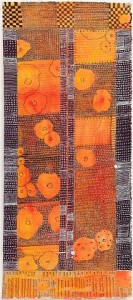
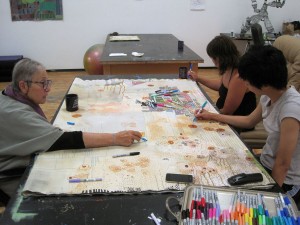
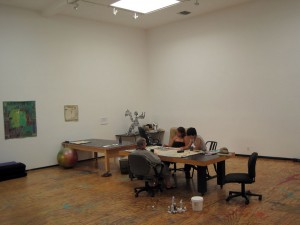

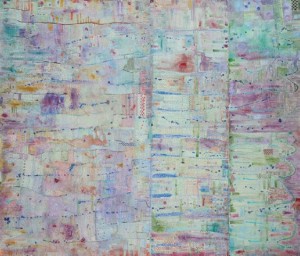
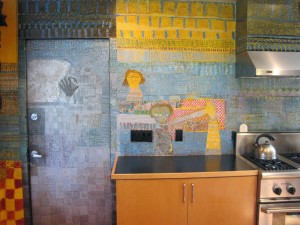

Dear Rene,
Thanks for the beautiful experience with this work and this fortunate space.
Dear Rene,
This is beautiful work! It very much appeals to me. thanks for the excellent write-up.
Renata Zerner
Very happy to see your works in IMA.April 2012.
We want to have some news to you. Do you remember your visit in Limousin, AIXE SUR VIENNE, with APOSTU in 1985.
greetings.we want to have your adress. Odile et Marc [msautivet@wanadoo.fr]